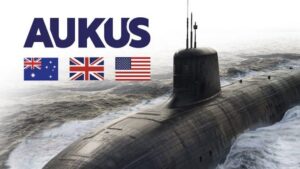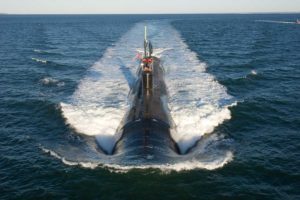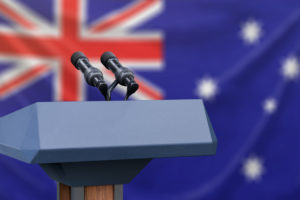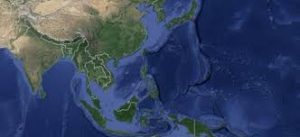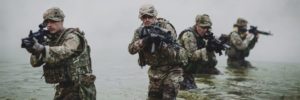[September 2022]
The new trilateral security partnership formed by Australia, the United Kingdom, and the United States adds a significant and crucial new dimension to grand strategy in the Pacific. In the official announcement of AUKUS in September 2021, the three nations emphasized their desire to share vital information and technology while creating deeper integration of security and defense-related science, technology, industry, and supply chains. Doing so will create distinct opportunities, challenges, and new realities that must be absorbed, analyzed, and—where necessary—acted upon in a direct and expedient fashion if the three nations are to take full advantage of the partnership.
The three nations share a rich history of alignment and formal alliance based on centuries of interaction going back to the colonization of Australia and the United States by Great Britain. It is well worth noting the essential maritime character of this triad, which stems from that shared history. Two of the nations, Australia and the United Kingdom, are literally islands. The United States, while a continental power with long land borders to the north and south, tends to think of itself as a maritime nation given its long history at sea, preeminent global Navy, and lengthy coastlines on both the Atlantic and Pacific.
This maritime character is reflected clearly in the first element of the AUKUS agreement, which paves the way for the acquisition of a powerful, nuclear-powered submarine force by Australia—matching at a smaller but still highly capable scale the long-experienced nuclear submarine forces of the United States and United Kingdom. In Washington, the agreement is being stewarded by two key defense leaders: Abe Denmark, working directly for Secretary of Defense Lloyd Austin; and Dr. James Miller, who is coordinating efforts at the White House on the National Security Staff. The agreement will provide the technology transfer and detailed professional training needed to construct, outfit, equip, and man a force of at least six nuclear-powered attack submarines over the next decade.
“Boosting all three countries’ military capabilities and our interoperability through AUKUS is critical to strengthening our deterrence posture and ensuring a free and open Indo-Pacific.” —Dr. James Miller
This will have a powerful effect on grand strategy in the western Pacific in three ways. First and most obviously, it will add a significant, forward-based, long-dwell (these boats can operate at depth for months at a time) attack force. It will immediately shift the military balance of power, most notably in the heavily contested South China Sea. At a second level, it will crack open the highly detailed and carefully constructed war plans of the United States to Australia and the United Kingdom, both of which would, logically, be expected to play a significant role in any conflict between the United States and China. And third, it would create a logistic structure that could conduct voyage repair at a very sophisticated level for both U.S. and UK nuclear submarine forces in the Indo-Pacific, an especially strategic region.
An attendant impact will be a far greater level of integration, interoperability, and exchange between the three navies. While there is already a robust level of interaction, the addition of the nuclear-powered force—essentially an infusion of a new cultural DNA into the Australian navy—will likely encourage more engagement between the sister services of the navies of the three countries. Most notably, perhaps, will be the impact on the U.S. Marine Corps, which is aggressively reshaping itself for combat operations in the South China Sea and will be looking for additional forward basing (there is already a significant contingent of Marines based in Darwin, Australia) and partnership from Australian land and air forces.
This will also have a catalyzing effect on grand strategy in intelligence sharing. As the three nations operate together militarily, the power and synergy of the “Five Eyes” arrangement (which adds Canada and New Zealand to the other three countries) will be enhanced; nuclear submarines and other maritime platforms are powerful and highly capable intelligence-gathering vessels. Finally, the synergies of technology-sharing will radiate far beyond the nuclear engineering. The so-called “front of the boat” (as opposed to the stern, where the nuclear reactor sits) is where advanced warfighting systems of sonar, torpedoes, land-attack cruise missiles, and fire control are resident. All of these will need to be integrated across the three navies regardless of the final design or propulsion system.
In terms of opportunities that stem from this alignment, several will impact the overall grand strategy in the region. First and foremost, it will have a deterrent effect on China’s claims to territorial control of the vast South China Sea—a body of water roughly half the size of the continental United States full of oil and gas and home to at least one-third of global shipping. Knowing that additional Western nuclear submarines are prowling those waters will circumscribe some of China’s ambitions.
It will also have a positive effect on some of the “swing states” in the balance between the United States and China. Nations on the periphery of the South China Sea—the Philippines, Vietnam, Thailand, Singapore, and Indonesia—will take notice of the increased activity from the triad of democracies. Although these peripheral nations will continue to hedge their bets with China, AUKUS is a powerful magnet that can help pull them toward the West.
Looking beyond the South China Sea, AUKUS’ impact on close U.S. allies Japan and South Korea is equally important. Both nations are perfectly capable of building and operating nuclear-powered submarines and may consider doing so. While both countries have cultural and historical barriers to making this leap, it would be powerful to add one or both to the nuclear-powered submarine team. Imagine the balance of power at sea in the Pacific if, for example, each of them decided to add a half-dozen nuclear-powered submarines at the quality point of the Australian boats. It would significantly complicate Beijing’s grand calculus.
Meanwhile, on the other side of the Strait of Malacca looms the emerging great power of India. The Indians already operate a nuclear-powered ballistic missile submarine, the Arihant class. The name means “slayer of enemies” in Sanskrit, and the class was constructed with significant technical assistance from Russia. India is also moving toward building nuclear attack submarines, and it is a tantalizing opportunity for AUKUS to consider how much engagement they desire with India. The “Quad” security alignment of the United States, Australia, Japan, and India has been a successful bulwark to Chinese ambition. Therefore, moving forward with some level of technology- and intelligence-sharing with India through AUKUS is a real opportunity for further deepening such cooperation.
Of course, there are many challenges. All of these AUKUS developments create real angst in Beijing. As the People’s Liberation Army’s Navy (PLAN) watches the Australian submarines become operational, they will be pressuring their national command authorities to respond forcefully. Their response will include constructing more and better nuclear attack submarines—the best counter to one of these lethal boats is, quite simply, another nuclear-powered submarine. They will lean on Russia for additional advanced technology and advice on how to improve the warfighting quality of their subsurface force. The PLAN will also build more of their very capable diesel boats; while not as capable as the nuclear-powered subs in the open ocean, they can be quite deadly in coastal waters, and the sheer quantity of them will pose problems for Western planners.
Putin’s Russia, crippled economically and diplomatically in the wake of the failing invasion of Ukraine, is sliding more and more toward the status of “junior partner” to China. Moscow will jump at the chance to provide its most capable submarine technology to the PLAN, seeking to cement the best possible terms for everything from sales of hydrocarbons to shared cyber intelligence. Thus, in a grand strategic sense, the alignment between Moscow and Beijing will only tighten, and the two countries’ navies will soon be training, exercising, and operating closely together—not only in the north Pacific, but globally. China and Russia will also enhance defense cooperation with Iran and North Korea, especially in the Pacific.
Another challenge to AUKUS may come from an unexpected quarter: European NATO members, particularly France. Paris is deeply upset at being upended on the multibillion dollar sale of submarines that the Australians canceled in favor of AUKUS. by virtue of their remaining possessions and long relationships in Micronesia. They will try to keep emphasis on the traditional defense commitments Washington and London have in Europe through NATO, and that may create some tensions. A smart play on the part of AUKUS would be to work closely with the French—who operate a very capable nuclear-powered submarine attack force—on joint exercising and training in the Pacific. The United States will have to thread the needle carefully in balancing its global defense commitments (especially in Europe in the wake of the Ukrainian invasion) with the long-term grand strategic challenge of China in the Pacific.
All of this will play out in a period of particular tension regarding the future of Taiwan. This is clearly the supreme redline for Beijing, and they will see additional military and diplomatic alignments—like AUKUS and its cousin the Quad—as inflammatory and dangerous. Both sides will need to operate with restraint, keep channels of communication (especially military-to-military) open, and avoid any precipitating event that could energize either AUKUS or China. The stakes are high, but so are the opportunities for the West.

